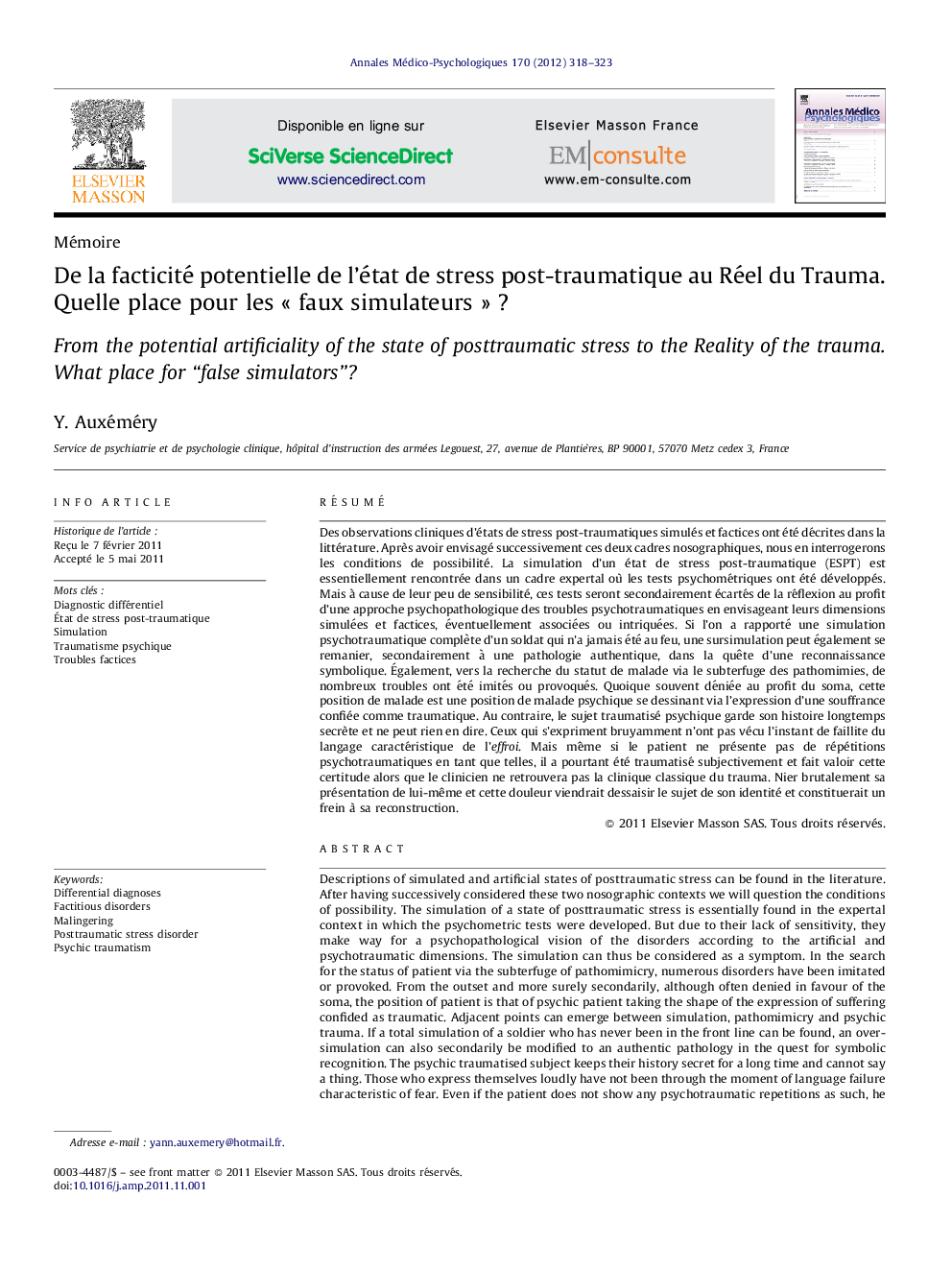| کد مقاله | کد نشریه | سال انتشار | مقاله انگلیسی | نسخه تمام متن |
|---|---|---|---|---|
| 312609 | 534233 | 2012 | 6 صفحه PDF | دانلود رایگان |

RésuméDes observations cliniques d’états de stress post-traumatiques simulés et factices ont été décrites dans la littérature. Après avoir envisagé successivement ces deux cadres nosographiques, nous en interrogerons les conditions de possibilité. La simulation d’un état de stress post-traumatique (ESPT) est essentiellement rencontrée dans un cadre expertal où les tests psychométriques ont été développés. Mais à cause de leur peu de sensibilité, ces tests seront secondairement écartés de la réflexion au profit d’une approche psychopathologique des troubles psychotraumatiques en envisageant leurs dimensions simulées et factices, éventuellement associées ou intriquées. Si l’on a rapporté une simulation psychotraumatique complète d’un soldat qui n’a jamais été au feu, une sursimulation peut également se remanier, secondairement à une pathologie authentique, dans la quête d’une reconnaissance symbolique. Également, vers la recherche du statut de malade via le subterfuge des pathomimies, de nombreux troubles ont été imités ou provoqués. Quoique souvent déniée au profit du soma, cette position de malade est une position de malade psychique se dessinant via l’expression d’une souffrance confiée comme traumatique. Au contraire, le sujet traumatisé psychique garde son histoire longtemps secrète et ne peut rien en dire. Ceux qui s’expriment bruyamment n’ont pas vécu l’instant de faillite du langage caractéristique de l’effroi. Mais même si le patient ne présente pas de répétitions psychotraumatiques en tant que telles, il a pourtant été traumatisé subjectivement et fait valoir cette certitude alors que le clinicien ne retrouvera pas la clinique classique du trauma. Nier brutalement sa présentation de lui-même et cette douleur viendrait dessaisir le sujet de son identité et constituerait un frein à sa reconstruction.
Descriptions of simulated and artificial states of posttraumatic stress can be found in the literature. After having successively considered these two nosographic contexts we will question the conditions of possibility. The simulation of a state of posttraumatic stress is essentially found in the expertal context in which the psychometric tests were developed. But due to their lack of sensitivity, they make way for a psychopathological vision of the disorders according to the artificial and psychotraumatic dimensions. The simulation can thus be considered as a symptom. In the search for the status of patient via the subterfuge of pathomimicry, numerous disorders have been imitated or provoked. From the outset and more surely secondarily, although often denied in favour of the soma, the position of patient is that of psychic patient taking the shape of the expression of suffering confided as traumatic. Adjacent points can emerge between simulation, pathomimicry and psychic trauma. If a total simulation of a soldier who has never been in the front line can be found, an over-simulation can also secondarily be modified to an authentic pathology in the quest for symbolic recognition. The psychic traumatised subject keeps their history secret for a long time and cannot say a thing. Those who express themselves loudly have not been through the moment of language failure characteristic of fear. Even if the patient does not show any psychotraumatic repetitions as such, he has still been traumatised in his mind and emphasizes this certainty whilst the clinician will not find the classical clinical of the trauma. Brutally deny this presentation of himself and the pain would divest the subject of their identity.
Journal: Annales Médico-psychologiques, revue psychiatrique - Volume 170, Issue 5, June 2012, Pages 318–323